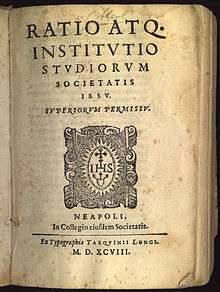Ratio Studiorum

The Ratio atque Institutio Studiorum Societatis Iesu (The Official Plan for Jesuit Education), often abbreviated as Ratio Studiorum (Latin: Plan of Studies), was a document that standardized the globally influential system of Jesuit education in 1599. It was a collection of regulations for school officials and teachers. The Ratio Studiorum relied on the classical subjects (theology, philosophy, Latin and Greek) and did not contain any provisions for elementary education. The document was revised in 1832, still built upon the classical subjects but giving more attention to the study of native languages of the students, history, geography, mathematics, and the natural sciences.
The work was the product of many hands and wide experience, but it most directly derives from the efforts of an international team of academics at the Collegio Romano, the Jesuit school in Rome. The Ratio had a major impact on later humanist education. In his Renaissance Literary Theory and Practice, Charles Sears Baldwin writes, "The sixteenth century closed with the full [classical] doctrine operative in the Ratio Studiorum and in the rhetoric of Soarez" (64).[1]
Historical background
The Society of Jesus had not originally envisaged running a network of schools when it was founded, but it soon became progressively involved in and then largely associated with educational work. One hundred years after the order's founding, the Jesuits were running 444 schools. By 1739, they were running 669 schools.[2] The many schools taken over or started by the Society in its first decades all needed plans (rationes). In addition, an increasing number of young men were entering the Society in need of the educational background that was required for priestly service, and the Society began to assume a greater and greater role in the direction of its own formational program. For these two reasons, there grew a great desire for a standard plan for all of the Society's educational institutions.
Under the generalate of Claudio Aquaviva, in 1581, a committee of twelve Jesuit priests was appointed without clear results. A new committee of six was soon formed in 1584: Juan Azor (Spain), Gaspar González (Portugal), James Tyrie (Scotland), Peter Busée (the Netherlands), Anthony Ghuse (Flanders), and Stephen Tucci (Sicily). This committee produced a trial document, the Ratio of 1586, which was sent to various provinces for comments from the teachers. This plan was not intended for actual use in the classrooms. Reflection on the reactions led to the issuance of another document in 1591, which was to be employed in all Jesuit schools for three years. The reflection on these experiments was then used by the committee in Rome to create the final official document of 1599.
Content
The Ratio Studiorum was divided into the following sections:[3]
I. Rules for the provincial superior; for the rector of the college; for the prefect of studies, who supervises classes and instruction, and the prefect of discipline, who maintains order and discipline;
II. Rules for the professors of theology: Scripture, Hebrew language, dogmatic theology, ecclesiastical history, canon law, and moral theology. St. Thomas Aquinas was the main author for theological texts.
III. Rules for the professors of philosophy, physics, and mathematics. Aristotle was prescribed as the standard author.
IV. Rules for the teachers of the studia inferiora (the lower department): Latin and Greek, grammar and syntax, humanities and rhetoric. Other subjects were taught from the beginning under the name of "accessories"—especially history, geography, and antiquities.
See also
References
- ↑ Baldwin, Charles Sears. Renaissance Literary Theory and Practice. New York: Columbia UP, 1939.
- ↑ Moss, Jean Dietz; Wallace, William A. (2003). Rhetoric & Dialectic in the Time of Galileo. Washington, D.C.: Catholic UP. p. 118. ISBN 9780813213316.
- ↑ Catholic Encyclopedia article on the Ratio Studiorum
Further reading
- Ratio atque Institutio Studiorum Societatis Iesu. Volume 5 of the Monumenta Paedagogica Societatis Iesu, ed. Ladislaus Lukàcs. Volume 129 of the series Monumenta Historica Societatis Iesu, 357-454. Rome: Institutum Historicum Societatis Iesu, 1986.
- Abbott, Don Paul. “Rhetoric and Writing in the Renaissance.” A Short History of Writing Instruction. Ed. James J. Murphy. Mahwah, NJ: Lawrence Erlbaum, 2001. 145–72.
- Atteberry, John. “Humanities and Rhetoric.” Ratio Studiorum: Jesuit Education 1540–1773. Ed. John Atteberry and John Russell. Boston: John J. Burns Library, 1999.
- Baldwin, Charles Sears. Renaissance Literary Theory and Practice. New York: Columbia UP, 1939.
- Donohue, John W., S.J. Jesuit Education: An Essay on the Foundation of Its Idea. New York: Fordham University Press, 1963.
- Farrell, Allan Peter, S.J. The Jesuit Code of Liberal Education; Development and Scope of the Ratio Studiorum. Milwaukee: Bruce Publishing Company, 1938.
- Ganss, George, S.J. Saint Ignatius' Idea of a Jesuit University. Second Edition. Milwaukee: Marquette University Press, 1956.
- Pavur, Claude, S.J. The Ratio Studiorum: The Official Plan for Jesuit Education. Saint Louis: The Institute of Jesuit Sources, 2005.
- Scaglione, Aldo. The Liberal Arts and the Jesuit College System. Philadelphia: John Benjamins Publishing Company, 1986.
- Schwickerath, Robert, S.J. Jesuit Education: Its History and Principles Viewed in the Light of Modern Educational Problems. Saint Louis, Missouri: B. Herder, 1903.
External links
- Catholic Encyclopedia article on the Ratio Studiorum
- "The Method of Teaching in Practice," a chapter from Jesuit Education: Its History and Principles Viewed in the Light of Modern Educational Problems by Robert Schwickerath, S.J. (with bibliography)
- Translation of the Ratio Studiorum by Allan P. Farrell, S.J., available in PDF or HTML